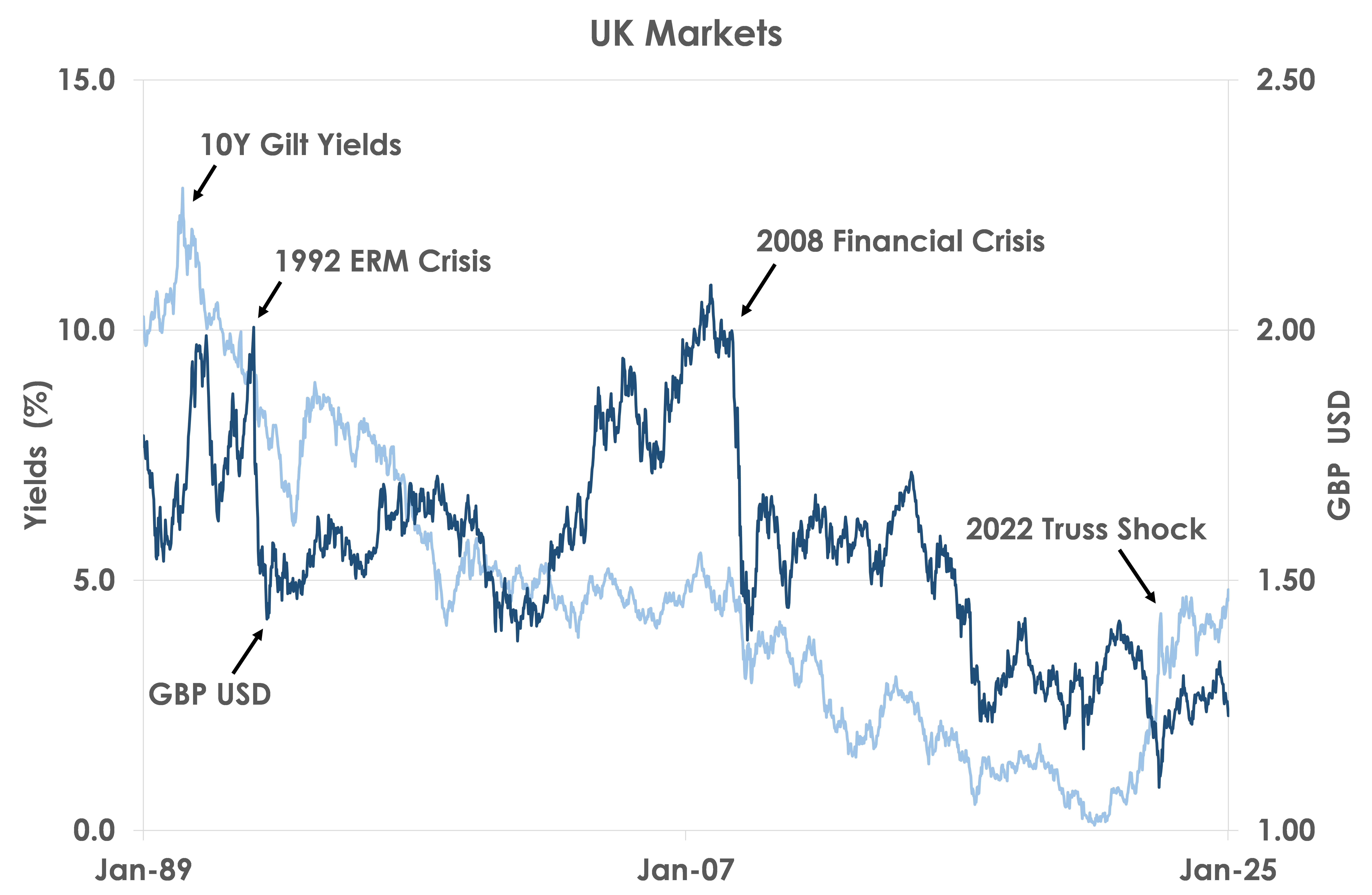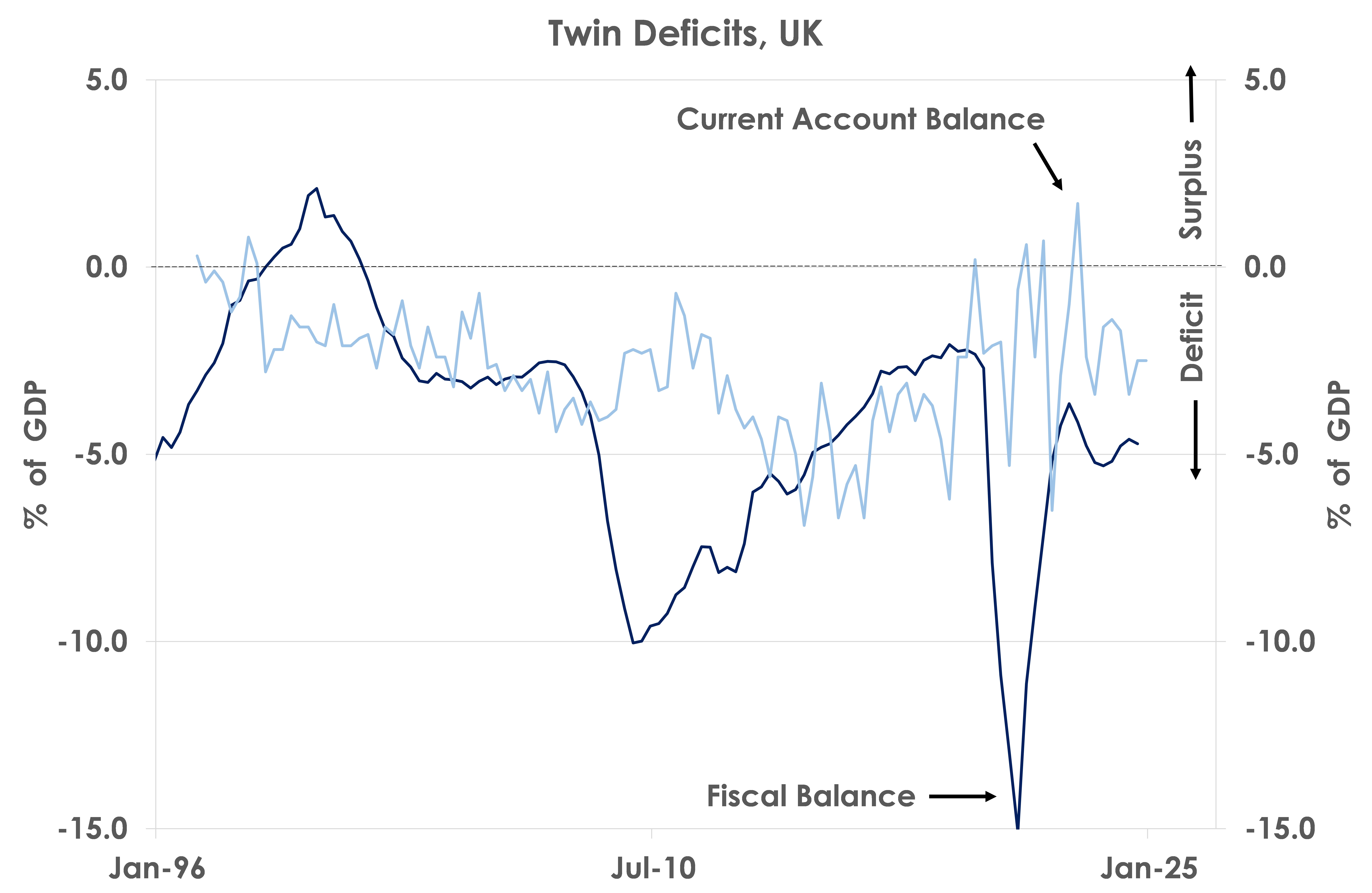
Britain's Former Prime Minister Liz Truss. AFP.
So far this year 10Y government bond (Gilt) yields have jumped 25bps to 4.83% and by 100bps since September to reach their highest levels since 2008. Similarly, the GBP has fallen from 1.34 to 1.22 against the USD.

Source: Bank of Singapore, Bloomberg
The sell-off in UK assets has three drivers. First, the new Labour government’s budget in October sharply increased borrowing by an average of GBP32.3 billion per year over the next five years, adding more than 1% of GDP to the UK’s already high fiscal deficit as the second chart shows.
Second, the latest UK data shows inflationary pressures remain stubborn. Headline inflation is near the Bank of England’s 2% target at 2.6% but core inflation is still 3.5% and services inflation 5.0%.

Source: Bank of Singapore, Bloomberg
At the same time, recent growth data has been weak. Monthly GDP has only risen once since May. Thus, investors fear the new government’s budget of higher spending and tax rises has hurt confidence, causing the economy to flirt with stagflation.
Third, global bond yields have also been rising. US 10Y Treasury yields have surged more than 100bps since September to 4.70% in anticipation of more inflationary policies during a second Trump term.
The sell-off in Gilts and the GBP has echoes of former Prime Minister Truss’s disastrous mini budget in 2022 when 10Y Gilt yields rocketed within days from 3.00% to 4.60% and the GBP fell to an all-time low of 1.03-1.04 against the USD. As the chart shows, the UK runs ‘twin deficits’ on its fiscal and current accounts so is dependent on maintaining investors’ confidence.
But we think the comparison is false. Instead, the weakness of UK assets may only be temporary rather than the start of a full-blown crisis. In contrast to Truss, Chancellor Reeves seems intent on meeting the UK’s fiscal rules constraining borrowing. If the Office for Budget Responsibility (OBR) Spring forecasts on March 26 show the rules are in breach, the government is set to reduce spending, most likely on investment. That may hurt near-term growth. But the Bank of England would respond by lowering interest rates faster than its current pace of quarterly 25bps cuts. We think fiscal tightening and further monetary easing would be sufficient to restore confidence, letting UK markets rebound from this year’s losses.
Important information
This product may only be offered: (i) in Hong Kong, to qualified Private Banking Customers and Professional Investors (as defined under the Securities and Futures Ordinance); and (ii) in Singapore, to Accredited Investors (as defined under the Securities and Futures Act) and (iii) in the Dubai International Financial Center to Professional Clients (as defined under the Dubai Financial Services Authority rules) only. No other person should act on the contents of this document.This product may involve derivatives. Do NOT invest in it unless you fully understand and are willing to assume the risks associated with it. If you have any doubt, you should seek independent professional financial, tax and/or legal advice as you deem necessary.
Please carefully read and make sure that you understand all Risk Disclosures, Selling Restrictions, and Disclaimers. This document must be read together with the relevant Prospectus & Offering Documents &/or Key Fact Statement.
Disclaimer
The Bank, its Affiliates and their respective employees are not in the business of providing, and do not provide, tax, accounting or legal advice to any clients. The material contained herein is prepared for informational purposes and is not intended or written to be used, and cannot be used or relied upon for tax, accounting or legal advice. Any such client is responsible for consulting his/her own independent advisor as to the tax, accounting and legal consequences associated with his/her investments/transactions based on the client’s particular circumstances.
This document and other related documents have not been reviewed by, registered or lodged as a prospectus, information memorandum or profile statement with the Monetary Authority of Singapore nor any regulator in Hong Kong or elsewhere.
This document may not be published, circulated, reproduced or distributed in whole or in part to any other person without the Bank’s prior written consent. This document is not intended for distribution to, publication or use by any person in any jurisdiction outside Singapore, Hong Kong, or such other jurisdiction as the Bank may determine in its absolute discretion, where such distribution, publication or use would be contrary to applicable law or would subject the Bank and its related corporations, connected persons, associated persons and/or affiliates (collectively, “Affiliates”) to any registration, licensing or other requirements within such jurisdiction.